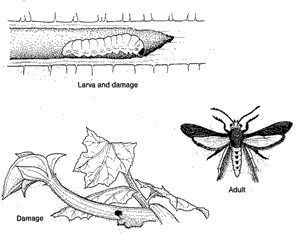 |
The squash vine borer is the larvae of the vine borer month (Melittia cucurbitae). In May, June or early July or just as squash is beginning to flower in your area, the adult moth lays eggs on the stems, usually within six inches of the ground. Found east of the Rockies. In the South there are two generations, eggs being laid in April as well as again in early summer.
The moth is 1 to 1 and 1/2 inches across at the wings. Its abdomen is colored with red, black, and copper rings. Its front wings are dark, and the rear wings are transparent. Moths fly early in the morning. The moth attaches tiny, dark disc-like eggs to the main stem near base of plant in late spring to early summer. Eggs are less than 1/10 inch in diameter and normally appear in short single rows or small clusters. Larvae hatch in 1 to 2 weeks and tunnel into the stem.
Fat, white inch-long caterpillars with brown heads hatch out and tunnel into the stems to feed, causing sudden wilting of all or part of a squash vine. They feed for 4 to 6 weeks, growing to an inch in length, at which time they burrow into the soil and make cocoons.
Over-winters in the soil, either in the larval or pupal stage, in a black cocoon. In late spring the pupa breaks through the end of the cocoon to the surface and emerges as a colorful wasp-like moth. You can spot them if you get to the garden between 6 and 8 am.
Symptoms of Squash Vine Borer
One day the vines look healthy, but on the next the plants wilt badly and the leaves turn black at the edges. The plant, at this point is nearly finished. Close inspection reveals a yellow sawdust-like material called frass at the base of the stems. Somewhere inside each plant, as many as 12 of the inch long white borers are munching away on the stems and at the same time injecting a toxin which causes wilting. If the stem of the wilted vine is cut open lengthwise, it will be filled with the frass and often one or more caterpillars. It only takes two or three larvae to knock a plant back. Inspect each vine carefully for a hole and a little pile of sawdust excrement near the base.

